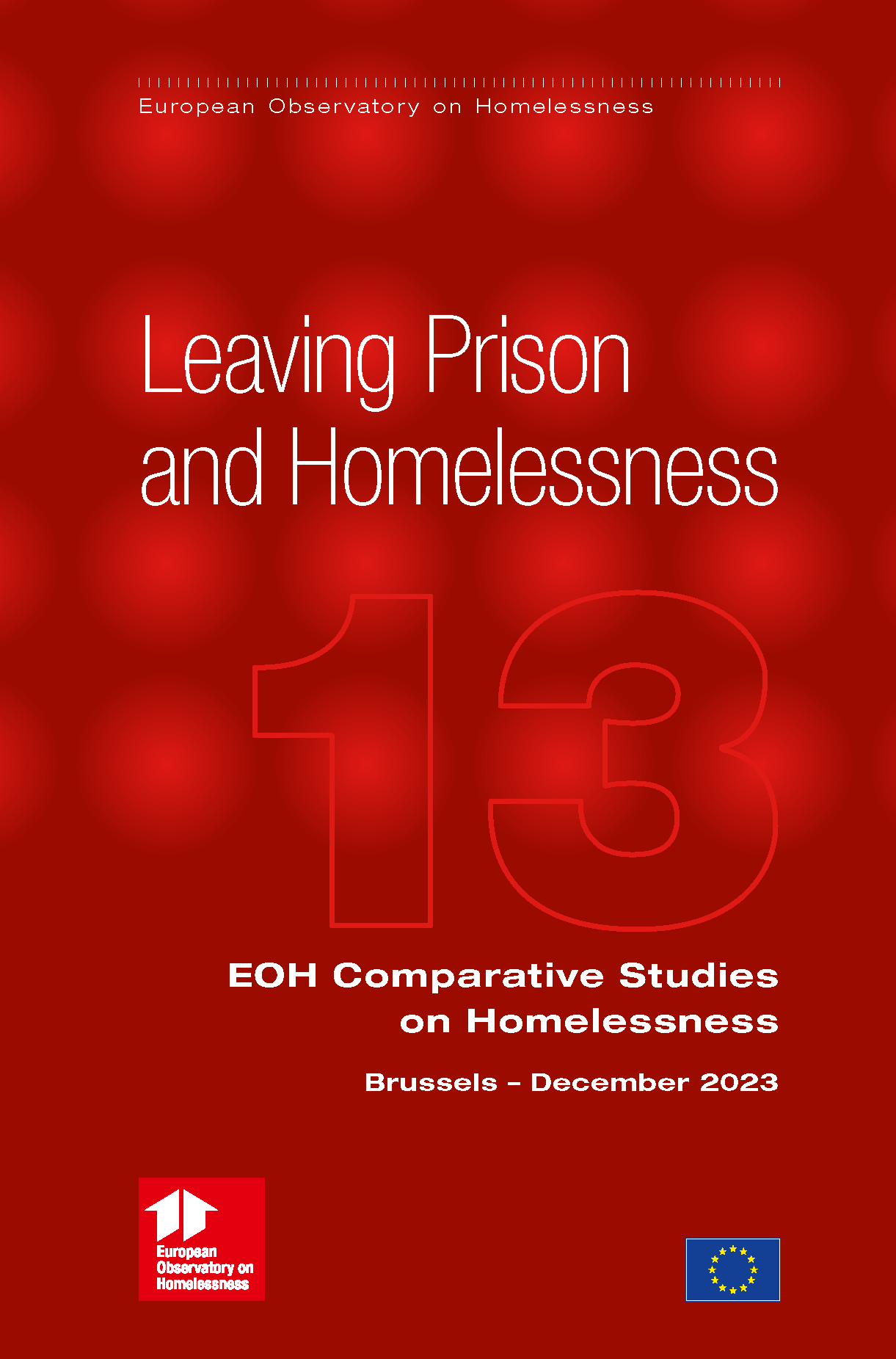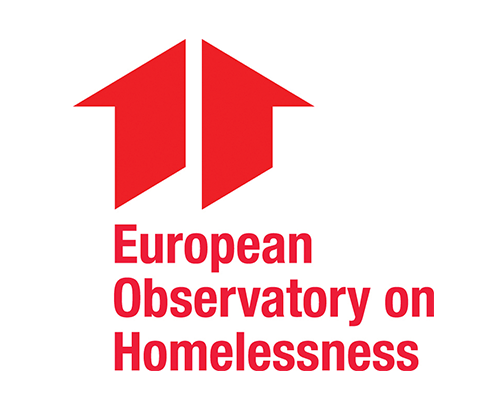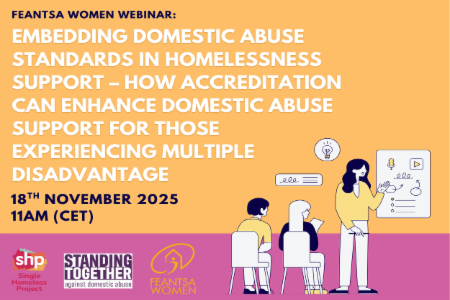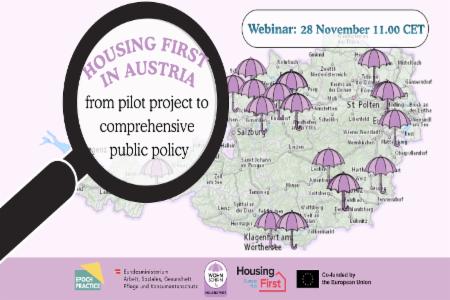Leaving Prison and Homelessness

Read and download the publication here (Online PDF)
This research explores the topic of imprisonment and homelessness across the EU. Release from prison can be a critical transition period that may involve the risk of homelessness if a housing solution and adequate support are not provided prior to and following release. A prison sentence may also result in homelessness when no mechanisms are in place to maintain an existing tenancy in the meantime. The study explores the existing evidence on the relationship between homelessness and imprisonment and current policy and practice in trying to prevent homelessness on leaving prison in 13 EU Member States and draws comparisons with two further European countries.
Summary
• This report is the 13th in an annual series of comparative studies of homelessness in Europe, conducted by the European Observatory on Homelessness (EOH). The Observatory operates under the auspices of FEANTSA, the European Federation of National Organisations Working with people experiencing homelessness.
• The concern of this research is with policies, practicalities, and protocols surrounding leaving prison, both at end of sentence or on early release, and how variations in the operation of those arrangements may intersect with homelessness. There is also analysis of how the needs, characteristics, experiences, and choices of people experiencing imprisonment might also influence their risk of homelessness.
• The research uses a comparative questionnaire prepared by EOH. Experts from 13 Member States and two other European countries were asked to summarise research, data, and, where necessary, conduct a small number of interviews to describe the nature and extent of the risk of homelessness among ex-prisoners. The Member States included were: Czechia; Denmark; France; Germany; Greece; Hungary; Ireland; Italy; Lithuania; Netherlands; Poland; Portugal; and Slovenia. The two other European countries were Norway and the UK.
• Criminal justice systems exist in multiple forms across Europe. There is also a lot of variation in the nature and range of custodial sentences and particularly the extent to which imprisonment is used. Some Member States and other European countries make much greater use of non-custodial (community) sentences than others. Even within individual countries, different forms of imprisonment exist, and the balance between high security and more open forms of prison can differ within countries, let alone among different countries.
• Overall rates of imprisonment across the EU are around 106 people per 100 000 population, but there is considerable variation within this. Some countries like Finland, Slovenia, and Germany imprison people at a much lower rate (under 80 per 100 000), while countries including Hungary and Poland imprison people at much higher rates (over 180 people per 100 000). Imprisoned populations are overwhelmingly male, i.e., typically around at least 95% of prisoners. The UK records people identifying as transgender in its prison populations, the level being approximately 0.25% of total prison population.
• Some EU Member States have significant numbers of foreign people in their prison systems. Existing data defines ‘foreign’ in broad terms, but this does include migrant populations. The great majority of people in prison in European countries are citizens of the country in which they are imprisoned.
• Another challenge in assessing the associations between prison and homelessness is that prison is never a constant experience at the European level. The nature and the likelihood of imprisonment varies markedly between EU Member States. Even within individual Member States, being in prison can mean very different things, depending on how someone is sentenced and the nature of their crimes.
• The EU Member States did not tend to have detailed data on the prevalence of homelessness among ex-prisoners. Data on the level of experience of prison among people experiencing homelessness were much more common, but these studies were sometimes focused on multiple need, high cost, high risk populations who were more likely to be experiencing recurrent or sustained homelessness. Research suggests an over-representation of ex-prisoners in at least some homeless populations, compared to experience of imprisonment across the general population and this same pattern was found by this research.
• Data on people entering prison from a situation of homelessness were also quite limited and quite variable across the EU Member States. However, while most people entering prison were not homeless, the rates at which homelessness was reported amongst new prisoners were often much higher than general populations.
• Housing precarity among ex-prisoners was often high. Many were reliant on family and friends for accommodation immediately after prison and were experiencing hidden homelessness. Any existing housing was more likely to be lost when serving long sentences.
• Risks of homelessness on leaving prison may not be immediate, but the high rate of housing precarity among ex-prisoners may increase risks of homelessness over time. For example, informal arrangements, including hidden homelessness, i.e., staying with relatives or friends because someone has nowhere else to go, may break down months or even years after imprisonment, leading to other forms of homelessness like sleeping on the street. Ex-prisoners could be in relatively vulnerable positions that placed them at greater risk of homelessness ultimately because being imprisoned had increased the risk of housing precarity.
• People entering prison often shared characteristics with people who are at heightened risk of homelessness in Europe, i.e., they were much more likely than the general population to have low educational attainment, sustained experience of poverty and socioeconomic exclusion, and higher rates of addiction, severe mental illness, and multiple treatment and support needs. Disentangling specific effects from being in prison and from leaving prison presented challenges when other situational and personal factors that are broadly associated with heightened risk of homelessness were also present.
• General drivers of homelessness, including shortages of affordable and (where present) social housing supply and shortfalls and limits in welfare system payments coverage of housing costs across several Member States, were often identified as important in making access to housing for ex-prisoners generally more difficult.
• Housing is often lost while in prison. Welfare and other social protection systems did not always provide cover for housing costs while someone is serving a sentence of a few weeks or months.
• Reluctance to house ex-prisoners among both private rented sector and social rented sector landlords was widely reported. Some particular crimes, such as a history of drug dealing or sexual offences, were more likely to be a barrier than others.
• In some Member States, practice in law enforcement can mean that street-based sleeping has criminogenic dimensions, i.e., it is shaped in part by laws and the implementation of those laws. However, the criminalisation of homelessness and the associations between criminality and homelessness are different issues. There is no real evidence to suggest that the associations between high rates of contact with criminal justice systems among high cost, high risk people experiencing homelessness stems from their being arrested and imprisoned for being homeless, rather there is a broad association between low level, repeated criminal activity and recurrent and sustained homelessness.
• Inadequate, inconsistent, and under-resourced support for prisoners who were at risk of homelessness when they left prison was widely reported. Member States with highly integrated and well-resourced systems of reintegration for ex-prisoners were the exception. Shortfalls between what was supposed to happen when someone was about to leave prison and the actual practice in prison, parole, and probation were reported in several Member States. Some European countries had prison systems that were generally overwhelmed and unable to deliver rehabilitation and resettlement because they were overcrowded.
• There was widespread policy awareness that stable housing was a prerequisite if policy and practice were to prevent recidivism (reoffending) among ex-prisoners. The logic being followed was that, without a stable home, reintegration could not be successful and, without reintegration, the risks of returning to prison were high. However, while several Member States and the other European countries in this research were reported as accepting this principle, they were often described as not implementing the policy and practice that would actually deliver stable housing solutions for ex-prisoners on a reliable basis.
• Reports of systems being siloed and uncoordinated were also widespread. There was generally no single authority or set of dedicated resources that had full responsibility for the process of ensuring housing was in place for ex-prisoners. Evidence of somewhat confused and haphazard sounding processes was more widespread than reports of highly integrated structures that ensured the right mix of agencies and services were in place.
• Outcomes for ex-prisoners who were at risk of homelessness were reported as too often being largely, or wholly, reliant on the degree of familial and broader social support they could access on leaving prison. Access to specialist projects for ex-prisoners designed to prevent homelessness, where such services were available, was often erratic and highly limited.
• Requirements for local connection in order to access housing and social protection services sometimes had the potential to influence housing and other outcomes for ex-prisoners who could not demonstrate a clear link to a specific municipality or local authority. If systems were organised nationally, e.g., there was no requirement to have a local connection to access welfare benefits or other support, this was less of an issue, something that was equally the case if specific arrangements to support ex-prisoners were in place.
• For a minority of ex-prisoners who are classified as potentially dangerous on release from prison, a policy failure to prevent homelessness represents potential risks to public safety. Ex-prisoners who represent potential risks to public safety who begin living on the street or experiencing hidden homelessness can quickly go off grid, i.e., they can become lost to public services and administration.




